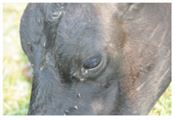Rotation Plan For Cattle Insecticide Ear Tags

Figure 1. Face flies.
Photo: Lee Townsend, UK
DR. LEE TOWNSEND
LEXINGTON, KY.
Insecticide-impregnated cattle ear tags have been a popular means of controlling pasture flies (horn fly and face fly) for over 20 years. The insecticide in the tag “blooms” from the plastic matrix and is then transferred to the animal’s hair coat. Also, the fly control program travels from pasture to pasture with the animal.
Avoiding Insecticide Resistance
Rotation of insecticides from year to year is recommended to reduce the chance of a problem with insecticide resistance, especially in horn fly populations. Resistance shows up in the form of a shorter than normal period of fly control. Changing tag brands is not enough; insecticides used in a rotation strategy must have a different mode of action than the previous product. Tags containing insecticides representing four different modes of action are available now and there are some combination tags that contain two different types in the same product.
Other Possible Causes of Reduced Control
Reduced fly control can be caused by factors other than resistance. Some examples:
1) Tagging too early. The 12- to 16-week “fly control clock” starts when tags are inserted. The amount of insecticide released from the tag is high at first, but the rate naturally declines over time. Tagging very early in spring can mean protection “runs out” before fly season is over.
2) Horn flies moving in from untreated nearby herds can keep pressure high and make your control seem less effective than it is.
3) Above normal rainfall can keep manure wetter for a longer period, as well as more suitable for horn fly breeding than during hot, dry summers when manure dries quickly and may be less hospitable for maggots.
Getting the Most of Ear Tag Programs
Here are some ways to get the most out of your ear tag-based pasture fly control program:
1) Rotate insecticide classes annually. Check the active ingredient in the tag to be sure you know what you are using and record the choice each year. The UK publication, Insecticide Recommendations for Beef (ENT-11), lists the tags by insecticide class. This makes it easier to establish a rotation.
2) Apply tags after horn fly numbers reach about 100 per side per animal. This will keep them from being applied too early. It takes more than 100 flies per side to have an impact on weight gain.
3) Supplement fly control with dust bags, oilers, sprays, or pour-ons, if needed. Staying on a pro-active program will keep resistance problems at bay.
Feed Additive Insecticides for Cattle Fly Control
Horn flies and face flies breed in cattle droppings in pastures. This is a weak link in the life cycle of these pests because the maggots are concentrated in the manure before they emerge as adults and attack animals. Manure piles are scattered over pastures; elimination of them or treatment of individual piles is impractical. However, manure can be made toxic if the animals consume an oral larvicide.
Mineral blocks or loose supplements that contain either an organophosphate insecticide or an insect growth regulator are available. Organophosphate insecticides work upon the nervous system of an insect, killing it quickly. An insect growth regulator interferes with the development of the insect, specifically the molting process. Every animal in the herd must consume at least a minimum effective dose for the manure to be toxic to the flies. These larvicides are labeled for horn fly control so other measures must be taken if face flies are a problem, too.
Feed-throughs are only a part of a total pasture fly control program because horn flies and face flies will move in from nearby herds. Supplemental control though the use of dust bags or backrubbers is needed to deal with these “fly-ins”. ∆
DR. LEE TOWNSEND: Extension Entomologist, University of Kentucky